Tennessee Valley Unitarian Church: The Beginning (1941-1951)
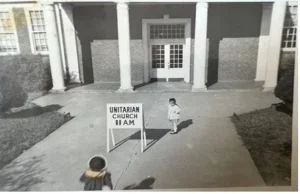 In 1948, several persons in the Knoxville area began planning the establishment of a Unitarian Church. There had been at least four other attempts to do this previously but they were hopeful this time they would be successful. With the aid of ministers supplied by the American Unitarian Association they held their first service in October of 1948 at Brownlow School. On February 6, 1949, 88 members signed a founding document, along with 24 members of the Oak Ridge Unitarian Church which was created simultaneously. Minister Richard (Dick) Henry was called and held his first service in October of 1949. By 1950 the Oak Ridge Unitarian Church had called its own minister and left to hold services on its own.
In 1948, several persons in the Knoxville area began planning the establishment of a Unitarian Church. There had been at least four other attempts to do this previously but they were hopeful this time they would be successful. With the aid of ministers supplied by the American Unitarian Association they held their first service in October of 1948 at Brownlow School. On February 6, 1949, 88 members signed a founding document, along with 24 members of the Oak Ridge Unitarian Church which was created simultaneously. Minister Richard (Dick) Henry was called and held his first service in October of 1949. By 1950 the Oak Ridge Unitarian Church had called its own minister and left to hold services on its own.
The Tennessee Valley Unitarian Church rented space at Christenberry Junior High School. In February of 1950 James Person, a retired African-American man, came to the front door. Seeing the sign that read “Everyone Welcome” he asked “Does that mean me?” In spite of customary and legally enforced segregation, Mr. Person was welcomed in and later joined the church. Because the congregation was now integrated, the church was no longer allowed to rent public space and had to move from Christenberry. This started what we call our “wandering in the wilderness” phase. The church held Sunday services in a variety of locations all over Knoxville. Phone calls were made and postcards sent each Monday, announcing the location of the next Sunday service. Station wagons full of metal folding chairs were hauled from place to place to provide seating. Temporary locations included a hotel lobby, a bank lobby, the Seventh Day Adventist Church, the YMCA and a movie theater. Despite these problems, the church refused to back down from being racially integrated. This experience only fueled the congregation’s multiple and vigorous efforts to end segregation in the area. One of the more notable efforts by the church was its support of Fellowship House Camps, a summer program held on the campus of Knoxville College to foster interracial play among children. This program continued from 1950 through 1973 and served, among others, Nikki Giovanni and future Mayor Dan Brown.
Unrest in Clinton, TN erupted in 1956 after a federal court, in line with recent Supreme Court decisions, ordered the desegregation of Clinton High School. Members of the church along with minister Richard Henry authored “A Declaration of Conscience.” This document deplored the recent harassment and violence in Clinton and called for peaceful solutions. It “went viral,” was distributed worldwide and gathered over 2000 signatures.
Unitarian House: 1951-1957
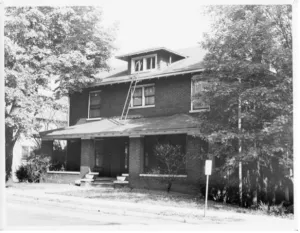 Tired of its nomadic existence, Tennessee Valley purchased a house on Clinch Avenue (still standing today). Worship services were held downstairs while children’s program were held upstairs (necessitating the rule that all children should take off their shoes so the minister could be heard). The building served multiple functions. As it was one of the very few spaces in Knoxville that would accommodate integrated groups, it served as a meeting place for professional associations, a venue for lectures and speakers, and a hostel for visiting integrated groups. One example was providing a meal for the Ohio State Symphonic Choir which was invited to Knoxville in 1952 by UTK but were refused meal service at the campus cafeteria because they were an integrated group.
Tired of its nomadic existence, Tennessee Valley purchased a house on Clinch Avenue (still standing today). Worship services were held downstairs while children’s program were held upstairs (necessitating the rule that all children should take off their shoes so the minister could be heard). The building served multiple functions. As it was one of the very few spaces in Knoxville that would accommodate integrated groups, it served as a meeting place for professional associations, a venue for lectures and speakers, and a hostel for visiting integrated groups. One example was providing a meal for the Ohio State Symphonic Choir which was invited to Knoxville in 1952 by UTK but were refused meal service at the campus cafeteria because they were an integrated group.
A Japanese visitor wrote, “When we arrived in Knoxville, the group assembled at Unitarian House, where an impressive scene awaited us. We saw a Negro conducting a chorus of white people — a scene I did not expect to see in the South.” The TVUC choir director at that time was Calvin Dash, assistant professor of vocal music at historically Black Knoxville College.
The First Building: 3219 Kingston Pike
1958 - 1998
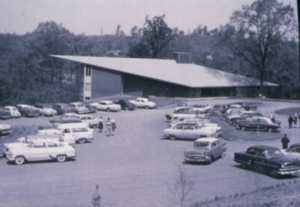
The church purchased land in 1950 for its first buiding, but it was not completed until 1958. The chosen designer was Hubert Bebb who also designed the Clingman’s Dome overlook and the sunsphere. The shape and the structure was meant to portray praying hands, though many thought it more resembled a spaceship. Nevertheless, it took its place among the many houses of worship that began populating Kingston Pike. Being seen as an equal among local religious local religious congregations was a symbolic victory for the once-ostracized Unitarians. Robert West had been called in 1957 as the minister for the church and led the congregation into its first original church building. Tennessee Valley congregants continued to be active in protesting segregation. Retail lunch counters, public restaurants and cafeterias, movie theaters and hospital cafeterias were targets of various protest methods, while letters were written and speeches given to public officials in support of desegregation. Eventually, Knoxville merchants and officials relented and segregation was officially ended without any violence, in contrast to many other Southern cities.
Over the next 40 years, the church grew significantly despite the opinion of the designer that there would “never be more than 100 Unitarians in Knoxville” which is why his design left few ways to expand the sanctuary space. One attempted renovation was scuttled by the finding of asbestos throughout the structure and the asbestos removal drained all the funds for renovation. A multi-purpose annex was built in the rear of the building in 1966. The Hunter house next door was purchased in 1986 to provide more and better office space. Multiple congregrants contributed to the renovation, including Carolyn Rogers’ and Paul Davis’s remodeling business which built the doors and walls in Hunter House to create the office spaces.
Tennessee Valley had several minsters during its time in this building. Following Robert West were Kenneth MacLean (1964-1972), John Buehrens (1973-1980), Robert Swain (1981-1990) and Lynn Strauss (1991-2000). Many persons held the job of Director of Religious Education with Reverend Mary Nelson holding the position the longest.
A new Unitarian congregation, Westside, was launched in 1986. Our congregation added “Universalist” to its name in 1991. The church was active in affairs of the national denomination, hosting and attending numerous conferences. The Reverends West and Buehrens were each elected to the position of President of the national Unitarian Universalist Association later in their careers.
Over its time at that location, the church was very active in a host of social action initiatives: segregation, the anti-evolution law, Bible study being required in public schools, criminal justice reform, the draft, the arms race, immigrant and refugee issues, food insecurity, homelessness, recycling and mental illness were all areas of concern. The topic of sex education was added to the church school curriculum in 1967 and continues to this day as the Our Whole Lives (OWL) class. The church became a welcoming Congregation — a UUA designation for being particularly open and welcoming to LGBTQ persons.
"The New Building:" The Early Years
2931 Kingston Pike
1998 - 2008
 The decaying mansion of Alexander Bonnyman was purchased by Tennessee Valley and, after some discussion, razed. A new building, designed to follow the contours of the site, was begun. The site of the 1793 log cabin of William Bell, the earliest built on Kingston Pike, was discovered on the southwest corner of the lot, which necessitated the creation of a deeply curved entrance into the church. The congregation moved into this new building in December of 1997 and held its first worship service there in early 1998. Pews with Christian crosses were purchased at a discount and reworked to have flaming chalices on the ends. The planned chapel on the south end of the building was not built due to financial constraints but the new space was a significant improvement over the previous building. The youth and the adult congregation no longer being separated “upstairs-downstairs” as in the previous buildings, and the addition of air conditioning were two of the many improvements.
The decaying mansion of Alexander Bonnyman was purchased by Tennessee Valley and, after some discussion, razed. A new building, designed to follow the contours of the site, was begun. The site of the 1793 log cabin of William Bell, the earliest built on Kingston Pike, was discovered on the southwest corner of the lot, which necessitated the creation of a deeply curved entrance into the church. The congregation moved into this new building in December of 1997 and held its first worship service there in early 1998. Pews with Christian crosses were purchased at a discount and reworked to have flaming chalices on the ends. The planned chapel on the south end of the building was not built due to financial constraints but the new space was a significant improvement over the previous building. The youth and the adult congregation no longer being separated “upstairs-downstairs” as in the previous buildings, and the addition of air conditioning were two of the many improvements.
Minister Lynn Strauss, having led the large effort of designing and moving to a new location, left TVUUC in 2000. In 2001 the church welcomed its seventh settled minister, Chris Buice. Reverend Buice had begun attending as a UTK student in the 1980’s. He had been hired as the Director of Religious Education in 1990 and later left to go to seminary. The church welcomed him back in 2001 with open arms and he remains the minister today.
Despite the major effort needed to fund and move into this new space, many social action efforts continued. Tutoring at Lonsdale School, a public school serving largely low income students in central Knoxville, began in 2000. The Hops and Hope 5K run was initiated and raised money for the FISH food program. Spectrum Café, a safe social event for LGBTQ youth was begun in 2001. The provision of meals for the Volunteer Ministry Program was begun in 2004. The congregation joined the Interfaith Hospitality Network to provide meals and temporary lodging for homeless families. The organization was later renamed as Family Promise and the program continues to this day. The church’s ongoing support of the Remote Area Medical (RAM) started in 2005.
The congregation worked to grow and began several initiatives to make newcomers feel welcome. Elements of the Hospitality Task Force remain in evidence today and include greeters at the front door, the rainbow plaque just outside the front door, sound baffling in the entryway, the Board Member on Duty introduction and welcome to the service, and the weekly Welcome Table in the foyer.
Congregational Trauma and Recovery: 2008-2010
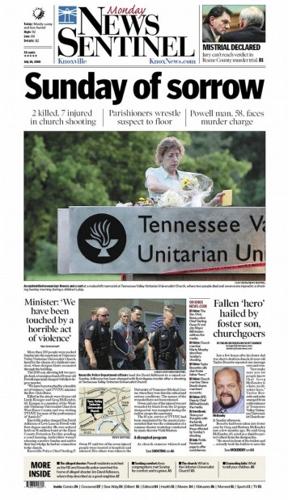 Former TVUUC Music Director Vicki Masters was an energetic and creative individual. One of her projects was to hold an annual summer music camp. On Sunday July 27, 2008 a packed congregation was present to witness the final project of that year’s camp, a full scale production of the musical “Annie Jr.” Minutes into the show, a gunman entered the rear of the sanctuary carrying a shotgun in a guitar case. He opened fire using pellets, hoping to inflict maximum damage on a congregation that he felt was too supportive of LGBTQ people and was “too liberal.” He was quickly subdued by multiple attendees but not before he had killed two people, injured eight and traumatized an entire congregation.
Former TVUUC Music Director Vicki Masters was an energetic and creative individual. One of her projects was to hold an annual summer music camp. On Sunday July 27, 2008 a packed congregation was present to witness the final project of that year’s camp, a full scale production of the musical “Annie Jr.” Minutes into the show, a gunman entered the rear of the sanctuary carrying a shotgun in a guitar case. He opened fire using pellets, hoping to inflict maximum damage on a congregation that he felt was too supportive of LGBTQ people and was “too liberal.” He was quickly subdued by multiple attendees but not before he had killed two people, injured eight and traumatized an entire congregation.
The church was quickly embraced by the multiple faith congregations in the area, the entire Knoxville community, the national Unitarian Universalist Association (UUA) and supporters from around the world. A community worship service was held the next night next door at Second Presbyterian Church, drawing many hundreds of attendees. The following Sunday ministers from all over the region and several former TVUUC minsters helped Reverend Buice lead a rededication of the violated sanctuary. Five hundred attendees were somehow crammed into the standing room only sanctuary and Fellowship Hall while the service was live-streamed to a packed conference room next door at the Teen Center and also broadcast live by several local TV Netwoks.
The rededication service only started the process of healing. Over the next year many activities and processes were carried out to facilitate recovery. The church worked with the local Red Cross and a trauma team sent by the UUA to create a network of emotional and psychological resources for congregants. Multiple support groups were created and met regularly. A UUA consultant was brought in to help the church to develop a strong ongoing social support network. A lay ministry group was trained to provide additional support in the work of pastoral care (this work continues today through our Spiritual Care team). Financial donations poured in from all over the world and were used to help all of the victims. The sanctuary was physically repaired, save one door that remained unchanged as a memorial for the events of that day. Two rooms in our building were renamed for each of the two persons killed, Greg McKendry and Linda Kreager. The church took steps to reaffirm its support of LGBTQ persons.
Over the next year, multiple issues were addressed using the many resources made available to assist the congregation in healing. One year after the shooting, a community musical concert “Instruments of Peace” was successfully held at the church, and our sincerest thanks to all those in the local community who rallied around to support us. The trauma revealed church organizational areas for improvement, and in late 2009 the church implemented a new method of a new staff/board organizational structure and policy governance that was better suited to the growing congregation. The attack did not deter our growth and as a result, a UU congregation was launched in Maryville, TN in 2008 named Foothills Unitarian Universalist Fellowship. By 2010 basic church processes had roughly returned to “normal.” However, many would say that the trauma and impact of that day continues to linger in church consciousness.
Our Current Building: 2011-Present
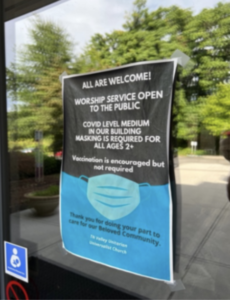 While no longer needing to focus heavily on obtaining a building or renovating an old one, there still have been some changes to building and grounds. Solar panels were installed on the roof in 2012, demonstrating our church’s commitment to environmental consciousness. Rather than just using our land for only lawn and flowers, a community vegetable garden and a food pantry was started in 2013. It continues to this day, providing food to those in need through various programs. Programmatically, the Share The Plate program, raising money for causes dear to the community, was initiated in 2013. The Children’s Diversity and Justice Library was started in 2019 and remains a strong embodiment of our values.
While no longer needing to focus heavily on obtaining a building or renovating an old one, there still have been some changes to building and grounds. Solar panels were installed on the roof in 2012, demonstrating our church’s commitment to environmental consciousness. Rather than just using our land for only lawn and flowers, a community vegetable garden and a food pantry was started in 2013. It continues to this day, providing food to those in need through various programs. Programmatically, the Share The Plate program, raising money for causes dear to the community, was initiated in 2013. The Children’s Diversity and Justice Library was started in 2019 and remains a strong embodiment of our values.
In early 2020 the nation faced an unexpected challenge, the COVID pandemic. The church stopped in-person worship and social gatherings in March of 2020. After a few months it became apparent that this would not be a short-lived problem and the church worked to adapt to the situation. Sunday worship services began to be broadcast through internet streaming and meetings were held virtually, a new process for most of us. A board and the congregation struggled with decisions on when to reopen and what safety measures would be taken when we did resume in-person social contact. The church reopened in October of 2021 using a hybrid model of in-person attendance with on-line broadcasting. Rising infection numbers caused another closure for a time in early 2022 but finally later in 2022 the church reopened for good, albeit with changes. The hybrid model of combining contact both in-person and with on-line video remains to this day. The test and strain of COVID disrupted almost all usual church functions but did prompt the church to adapt. The installation of cameras in the sanctuary now enables regular broadcasting of Sunday worship services, reaching a global audience and regular viewers around the world.
In 2019 the church took the opportunity to hire an Assistant Minister. Reverend Jametta Alston was an African-American Christian minister who was principally charged with handling pastoral care. For some congregants it was a new and growing experience to be comforted and ministered to by a Black female minister. For her, the challenge was to provide meaningful pastoral care during a pandemic when close social contact was not advised. Unfortunately, health problems forced her to leave this ministry in 2021. Since the abatement of COVID the church has continued its long-standing commitment to a wide variety of social justice issues while offering a spiritual home to persons of many persuasions. “Love is the Spirit of This Church” and “Everyone Welcome” remain the cornerstones of the congregation.
